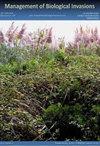Rotenone application and degradation following eradication of invasive roach (Rutilus rutilus) in three Norwegian lakes
IF 1.2
4区 环境科学与生态学
Q3 BIODIVERSITY CONSERVATION
引用次数: 2
Abstract
Roach (Rutilus rutilus) is indigenous to south-eastern Norway and alien to the rest of the country. In Trondheim municipality, in the middle part of Norway, roach was introduced into the Ila watercourse in 1881. Roach has a great potential to alter the ecosystem when introduced to new locations. The potential negative impact on potable water source quality and the prospect of permanently eradicating an alien species resulted in rotenone treatment of six lakes in Trondheim municipality. The rotenone concentration in the lakes was surveyed by water sampling until it could no longer be detected. A lethal concentration of rotenone at all test points was measured in all lakes during the survey period. Fourteen days after treatment, a near homogenous concentration was reached. The concentration reduction was similar in the lakes and relatively quicker during the first weeks after treatment. It was also consistent between depths except for the surface, where the concentration degraded more quickly. Rotenone degradation is a key factor when planning eradication efforts, and reports on this varies considerably between different locations. Despite application of rotenone in different depth strata, it took several days to reach homogenous concentration and several months and a fall turnover for the rotenone to break down and dilute below the detection limit in the lakes described.在挪威三个湖泊消灭入侵蟑螂(Rutilus Rutilus)后鱼藤酮的应用和降解
蟑螂(Rutilus Rutilus)原产于挪威东南部,是该国其他地区的外来物种。在挪威中部的特隆赫姆市,蟑螂于1881年被引入伊拉水道。当蟑螂被引入到新的地方时,它有很大的潜力改变生态系统。对饮用水源质量的潜在负面影响和永久根除外来物种的前景导致特隆赫姆市的六个湖泊进行鱼藤酮处理。对湖泊中的鱼藤酮浓度进行了抽样调查,直到无法检测到为止。在调查期间,所有湖泊的所有测试点都测量到了鱼藤酮的致死浓度。治疗14天后,达到接近均匀的浓度。在治疗后的第一周内,湖泊中的浓度下降幅度相似且相对较快。除了表层,不同深度之间的浓度也是一致的,因为表层的浓度下降得更快。鱼藤酮降解是规划根除工作时的一个关键因素,不同地区关于这方面的报告差别很大。尽管在不同深度的地层中应用了鱼藤酮,但鱼藤酮达到均匀浓度需要几天的时间,而在上述湖泊中,鱼藤酮分解和稀释到检测极限以下需要几个月和一个秋天的周转。
本文章由计算机程序翻译,如有差异,请以英文原文为准。
求助全文
约1分钟内获得全文
求助全文
来源期刊

Management of Biological Invasions
Agricultural and Biological Sciences-Ecology, Evolution, Behavior and Systematics
CiteScore
3.40
自引率
6.70%
发文量
21
审稿时长
16 weeks
期刊介绍:
Management of Biological Invasions, established in 2010 by Dr. Elias Dana, is an open access, peer-reviewed international journal focusing on applied research in biological invasions in aquatic and terrestrial ecosystems from around the world. This journal is devoted to bridging the gap between scientific research and the use of science in decision-making, regulation and management in the area of invasive species introduction and biodiversity conservation.
Managing biological invasions is a crisis science, with Management of Biological Invasions aiming to provide insights to the issues, to document new forms of detection, measurements and analysis, and to document tangible solutions to this problem.
In addition to original research on applied issues, Management of Biological Invasions publishes technical reports on new management technologies of invasive species and also the proceedings of relevant international meetings. As a platform to encourage informed discussion on matters of national and international importance, we publish viewpoint papers that highlight emerging issues, showcase initiatives, and present opinions of leading researchers.
 求助内容:
求助内容: 应助结果提醒方式:
应助结果提醒方式:


